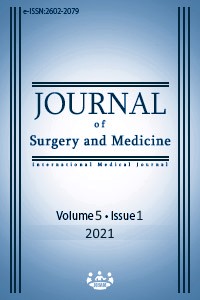Serum adropin and nitric oxide levels in missed abortus cases
Keywords:
Missed Abortus, Adropin, Nitrik OxideAbstract
Background/Aim: Missed abortus is an emergency obstetric pathology, defined as intrauterine fetal viability loss before the 20th week of pregnancy. It is known that there is a correlation between endothelium dysfunction, neovascularization, hemodynamic regulation and adropin and nitric oxide levels. In this study, it is intended to research the possible roles of adropin and nitric levels in etiopathogenesis. Methods: In this case-control study, a total of fifty-nine volunteers, including healthy pregnant women and missed abortion cases, were included in the study. They were divided into 2 groups, as healthy individuals (Group 1, n=29), and those diagnosed with missed abortus (Group 2, n=30). Group 2 patients were followed weekly until β-HCG values fell below 5 ng/ml after termination. Serum adropin and nitric oxide levels were measured in all participants and those diagnosed with missed abortion when negative β-HCG value was obtained after termination. Results: Serum adropin and nitric oxide levels were significantly low in the missed abortus group (P=0.03) compared to healthy pregnant women, and in the missed abortus group compared to those whose β-HCG fell below 5 ng/ml after termination (P=0.02), while nitric oxide levels were similar in the latter comparison (P=0.38). Regarding age, body mass index, obstetric parameters, and other biochemical parameters, the two groups were similar (P>0.05 for each). Conclusion: This is the first research which evaluates adropin levels in missed abortus cases. Lower adropin and nitric oxide levels in missed abortus cases, and their increase after post-termination show that they may be playing a role in abortus etiopathogenesis.
Downloads
References
Beksaç S. Erken gebelik problemleri ve düşükler. In:Beksaç S, Demir N, Koç A, Yüksel A, eds. Obstetrik Maternal Fetal Tıp ve Perinatoloji, 1. Baskı. Ankara: Medikal Network Nobel KitabevI; 2001. pp. 1076–85.
Fang Y, Kong B, Yang Q, MaD, Qu X. MDM2 309 polymorphism is associated with missed abortion. Hum Reprod. 2009;24:1346–9.
Butler AA, Tam CS, Stanhope KL, Wolfe BM, Ali MR, O’Keeffe M, et al. Low circulating Adropin concentrations with obesity and aging correlate with riskfactors for metabolic disease and increase after gastric bypass surgery inhumans. J Clin Endocrinol Metab. 2012;97:3783-91.
Lovren F, Pan Y, Quan A, Singh KK, Shukla PC, Gupta M, et al. Adropin is a novel regulator of endothelial function. Circulation. 2010;122:185-92.
Lin D, Yong J, Ni S, Ou W, Tan X. Negative association between serum adropin and hypertensive disorders complicating pregnancy. Hypertens Pregnancy. 2019;38:237-44.
Lowenstein CJ, Dinerman JL, Snyder S. Nitric oxide: a physiologic messenger. Ann Intern Med. 1994;120:227-37.
Xu WM, Liu LZ. Nitric oxide: from a mysterious labile factor to the molecule of the Nobel Prize. Recent progress in nitric oxide research. Cell Res. 1998;8:251-58.
Kumar KG, Trevaskis JL, Lam DD, Sutton GM, Koza RA, Chouljenko VN, et al. Identification of adropin as a secreted factor linking dietary macronutrient intake with energy homeostasis and lipid metabolism. Cell Metab. 2008;8:468-81.
Aydin S, Kuloglu T, Eren MN, Yilmaz M, Kalayci M, Sahin I, et al. Expression of adropin in rat brain, cerebellum, kidneys, heart, liver, and pancreas in streptozotocin-induced diabetes. Mol Cell Biochem. 2013;380:73-81.
Kuloglu T, Aydin S. Immunohistochemical expressions of adropin and inducible nitric oxide synthase in renal tissues of rats with streptozotocininduced experimental diabetes. Biotech Histochem. 2014;89:104-10.
Qiu X, He JR, Zhao MG, Kuang YS, Xu SQ, Zhang HZ, et al. Relationship between human cord blood adropin levels and fetal growth. Peptides. 2014;52:19-22.
Gupta S, Agarwal A, Banerjee J, Alvarez JG. The role of oxidative stress in spontaneous abortion and recurrent pregnancy loss: a systematic review. Obstet Gynecol Surv. 2007;62:335-47.
Topuz M, Celik A, Aslantas T, Demir AK, Aydin S. Plasma adropin levels predict endothelial dysfunction like flow-mediated dilatation in patients with type 2 diabetes mellitus. J Investig Med. 2013;61:1161-64.
Romero R, Espinoza J, Kusanovic JP, Gotsch F, Hassan S, Erez O, et al. The preterm parturition syndrome. BJOG. 2006;113:17-42.
Krause BJ, Hanson MA, Casanello P. Role of nitric oxide in placental vascular development and function. Placenta. 2011;32:797-805.
Paradisi R, Fabbri R, Battaglia C, Facchinetti F, Venturoli S. Nitric oxide levels in women with missed and threatened abortion: results of a pilot study. Fertil Steril. 2007;88:744-8.
Baka S, Puchner MA, Briana DD, Boutsikou M, Marmarinos A, Gourgiotis D, et al. Adropin concentrations in term pregnancies with normal, restricted and increased fetal growth. J Matern Fetal Neonatal Med. 2016;29:2403-07.
Downloads
- 402 536
Published
Issue
Section
How to Cite
License
Copyright (c) 2021 Hacer Paşaoğlu, Rulin Deniz
This work is licensed under a Creative Commons Attribution-NonCommercial-NoDerivatives 4.0 International License.
















